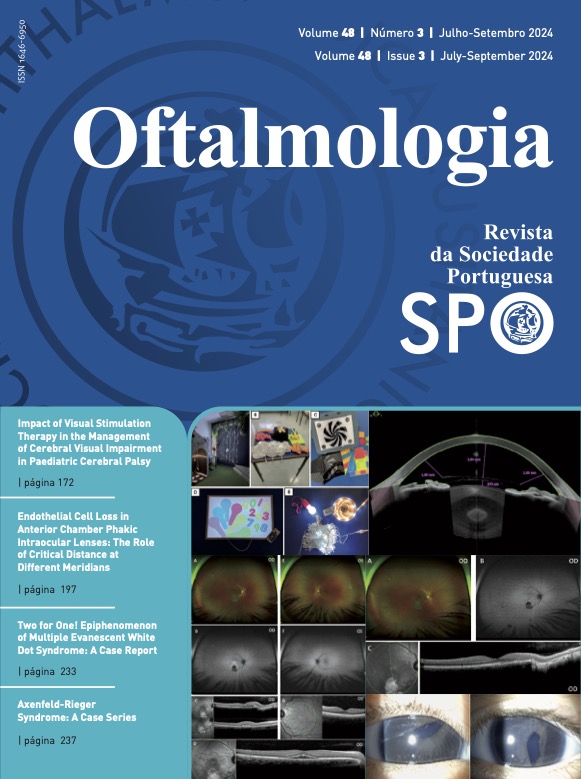Clinical and Genetic Spectrum of Pediatric IRDs in Portugal: Data from the IRD-PT Registry
DOI:
https://doi.org/10.48560/rspo.32932Keywords:
Child, Genetic Diseases, Inborn, Genetic Testing, Retinal Dystrophies/geneticsAbstract
INTRODUCTION: Inherited retinal dystrophies (IRDs) are a major cause of childhood blindness, but to date, no national population-based study regarding the clinical and genetic spectrum of these disorders has been conducted. Thus, this study aimed to characterize the clinical and molecular spectrum of pediatric IRDs in Portugal.METHODS: Multicenter, cross-sectional, cohort study of consecutive 79 pediatric patients (age < 18 years old), 70 of which unrelated, with a clinical diagnosis of IRD and available genetic testing results, identified via the IRD-PT registry. Phenotype parameters included age of onset, first visual symptom and clinical phenotype based on ophthalmological examination and deep phenotyping. Genetic testing was clinically oriented in all probands and included Sanger sequencing, next-generation sequencing (NGS) or whole exome sequencing (WES)-based panels. Variants were classified in accordance with the American College of Medical Genetics and Genomics (ACMG). Only pathogenic (class V) or likely pathogenic (class IV) variants were considered to establish a molecular diagnosis.
RESULTS: A genetically confirmed diagnosis was achieved in 56/70 (80.0%) families. The most prevalent diagnoses were rod-cone dystrophy (RCD) in 15 patients and cone/cone-rod dystrophy (COD/CORD) in 14 patients. Leber congenital amaurosis (LCA) and albinism were observed in 7 subjects each, X-linked retinoschisis (XLRS) in 6, Usher syndrome in 6, Best disease and achromatopsia in 4 each, Bardet-Biedl syndrome (BBS) in 3, Stickler syndrome, congenital stationary night blindness (CSNB) and Heimler syndrome in 2, and Stargardt disease (STGD), KearnsSayre syndrome (KSS), Cohen syndrome, hypotrichosis with juvenile macular dystrophy (HJMD), methylmalonic aciduria (MMA), Liberfarb disease and neuropathy, ataxia and retinitis pigmen- tosa (NARP) syndrome in 1 subject each. Almost 2/3 (65.8%) of patients initiated symptoms before 6 years old, with nystagmus and vision loss being the most frequently reported symptoms. A total of 59 disease-causing variants were identified distributed across 34 different genes, with ABCA4 (n=5 families) and RS1 (n=5) being the most frequently mutated genes.
CONCLUSION: Our results shed light on the clinical and genomic landscape of pediatric IRDs in Portugal. The fact that the majority of children-initiated symptoms before 6 years old highlights the importance of a high level of suspicion to establish an early diagnosis.
Downloads
References
Schneider N, Sundaresan Y, Gopalakrishnan P, Beryozkin A, Hanany M, Levanon EY, et al. Inherited retinal diseases: Linking genes, disease-causing variants, and relevant therapeutic modalities. Prog Retin Eye Res. 2022;89:101029. doi: 10.1016/j.preteyeres.2021.101029.
Broadgate S, Yu J, Downes SM, Halford S. Unravelling the genetics of inherited retinal dystrophies: past, present and future. Prog Retin Eye Res. 2017;59:53–96.
Suppiej A, Ceccato C, Maritan V, Cermakova I, Colavito D, Leon A. Exome sequencing and electro-clinical features in pediatric patients with very early-onset retinal dystrophies: A cohort study. Eur J Paediatr Neurol. 2021;31:1-9. doi: 10.1016/j.ejpn.2021.01.003.
Sirkka-Liisa Rudanko SL, Laatikainen L. Visual Impairment in Children Born at Full Term from 1972 through 1989 in Finland. Ophthalmology. 2004;111:2307–2312.
Suppiej A, Marino S, Reffo ME, Maritan V, Vitaliti G, Mailo J, et al. Early onset retinal dystrophies: clinical clues to diagnosis for pediatricians. Ital J Pediatr. 2019;45:168. doi: 10.1186/s13052-019-0760-5.
Jauregui R, Cho GY, Takahashi VK, Takiuti JT, Bassuk AG, Mahajan VB, et al. Caring for Hereditary Childhood Retinal Blindness. Asia Pac J Ophthalmol. 2018;7:183-91. doi: 10.22608/APO.201851.
Teoh LJ, Solebo AL, Rahi JS; British Childhood Visual Impairment and Blindness Study Interest Group. Visual impairment, severe visual impairment, and blindness in children in Britain (BCVIS2): a national observational study. Lancet Child Adolesc Health. 2021;5:190-200. doi: 10.1016/S2352-4642(20)30366-7. Erratum in: Lancet Child Adolesc Health. 2021;5:e18.
Silveira S, Martin FJ, Flaherty M, Russell HC. Reporting on Australian childhood visual impairment: the first 10 years. Eye. 2022;361412-8. doi: 10.1038/s41433-021-01656-1.
Yahalom C, Braun R, Patal R, Saadeh I, Blumenfeld A, Macarov M, et al. Childhood visual impairment and blindness: 5-year data from a tertiary low vision center in Israel. Eye. 2022;36:2052-6. doi: 10.1038/s41433-021-01743-3.
Hull S, Kiray G, Chiang JP, Vincent AL. Molecular and phenotypic investigation of a New Zealand cohort of childhood-onset retinal dystrophy. Am J Med Genet C Semin Med Genet. 2020;184:708-17. doi: 10.1002/ajmg.c.31836.
Marques JP, Carvalho AL, Henriques J, Murta JN, Saraiva J, Silva R. Design, development and deployment of a web-based interoperable registry for inherited retinal dystrophies in Portugal: the IRD-PT. Orphanet J Rare Dis. 2020;15:304. doi: 10.1186/s13023-020-01591-6.
Richards S, Aziz N, Bale S, Bick D, Das S, Gastier-Foster J, et al. Standards and guidelines for the interpretation of sequence variants: a joint consensus recommendation of the American College of Medical Genetics and Genomics and the Association for Molecular Pathology. Genet Med. 2015;17:405-24. doi: 10.1038/gim.2015.30..
Khan AO. Phenotype-guided genetic testing of pediatric inherited retinal disease in the United Arab Emirates. Retina. 2020;40:1829-37.
Hamblion EL, Moore AT, Rahi JS; British Childhood Onset Hereditary Retinal Disorders Network. Incidence and patterns of detection and management of childhood-onset hereditary retinal disorders in the UK. Br J Ophthalmol. 2012;96:360-5. doi: 10.1136/bjo.2010.201178.
Prokofyeva E, Troeger E, Wilke R, Zrenner E. Early visual symptom patterns in inherited retinal dystrophies. Ophthalmologica. 2011;226:151–6.
Verbakel SK, van Huet RA, Boon CJ, den Hollander AI, Collin RW, Klaver CC, et al. Non-syndromic retinitis pigmentosa. Prog Retin Eye Res. 2018;66:157-86. doi: 10.1016/j.preteyeres.2018.03.005.
Taylor RL, Parry NR, Barton SJ, Campbell C, Delaney CM, Ellingford JM, et al. Panel-Based Clinical Genetic Testing in 85 Children with Inherited Retinal Disease. Ophthalmology. 2017;124:985-91. doi: 10.1016/j.ophtha.2017.02.005.
Stone EM, Andorf JL, Whitmore SS, DeLuca AP, Giacalone JC, Streb LM, et al. Clinically Focused Molecular Investigation of 1000 Consecutive Families with Inherited Retinal Disease. Ophthalmology. 2017;124:1314-31. doi: 10.1016/j.ophtha.2017.04.008.
Weisschuh N, Obermaier CD, Battke F, Bernd A, Kuehlewein L, Nasser F, et al. Genetic architecture of inherited retinal degeneration in Germany: A large cohort study from a single diagnostic center over a 9-year period. Hum Mutat. 2020;41:1514-27. doi: 10.1002/humu.24064.
Zhao L, Wang F, Wang H, Li Y, Alexander S, Wang K, et al. Next-generation sequencing-based molecular diagnosis of 82 retinitis pigmentosa probands from Northern Ireland. Hum Genet. 2015;134:217-30. doi: 10.1007/s00439-014-1512-7.
Gao FJ, et al. Genetic and Clinical Findings in a Large Cohort of Chinese Patients with Suspected Retinitis Pigmentosa. Ophthalmology. 2019;126(11):1549-56.
Marques JP, Marta A, Geada S, Carvalho AL, Menéres P, Murta J, et al. Clinical/Demographic Functional Testing and Multimodal Imaging Differences between Genetically Solved and Unsolved Retinitis Pigmentosa. Ophthalmologica. 2022;245:134-43. doi: 10.1159/000520305.
Shanks ME, Downes SM, Copley RR, Lise S, Broxholme J, Hudspith KA, et al. Next-generation sequencing (NGS) as a diagnostic tool for retinal degeneration reveals a much higher detection rate in early-onset disease. Eur J Hum Genet. 2013;21:274-80. doi: 10.1038/ejhg.2012.172. Erratum in: Eur J Hum Genet. 2013;21:1031.
Holtan JP, Aukrust I, Jansson RW, Berland S, Bruland O, Gjerde BL, et al. Clinical features and molecular genetics of patients with ABCA4-retinal dystrophies. Acta Ophthalmol. 2021;99:e733-46. doi: 10.1111/aos.14679.
Kumaran N, Moore AT, Weleber RG, Michaelides M. Leber congenital amaurosis/early-onset severe retinal dystrophy: clinical features, molecular genetics and therapeutic interventions. Br J Ophthalmol. 2017;101:1147-54. doi: 10.1136/bjophthalmol-2016-309975.
Xu K, Xie Y, Sun T, Zhang X, Chen C, Li Y. Genetic and clinical findings in a Chinese cohort with Leber congenital amaurosis and early onset severe retinal dystrophy. Br J Ophthalmol. 2020;104:932-7. doi: 10.1136/bjophthalmol-2019-314281.
Sallum JM, Motta FL, Arno G, Porto FB, Resende RG, Belfort R Jr. Clinical and molecular findings in a cohort of 152 Brazilian severe early onset inherited retinal dystrophy patients. Am J Med Genet C Semin Med Genet. 2020;184:728-52. doi: 10.1002/ajmg.c.31828.
Downloads
Published
How to Cite
Issue
Section
License
Copyright (c) 2024 Revista Sociedade Portuguesa de Oftalmologia

This work is licensed under a Creative Commons Attribution-NonCommercial 4.0 International License.
Do not forget to download the Authorship responsibility statement/Authorization for Publication and Conflict of Interest.
The article can only be submitted with these two documents.
To obtain the Authorship responsibility statement/Authorization for Publication file, click here.
To obtain the Conflict of Interest file (ICMJE template), click here





